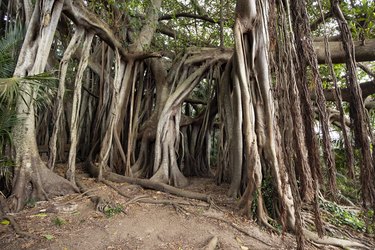
Many of the world's most iconic trees are tropical trees that are found in warm climates close to the equator. They include many well-known fruit-bearing trees that are cultivated commercially well beyond their native regions as well as massive shade species that dwell deep in rain forests and sustain entire ecosystems.
Tropical Palm Trees
Video of the Day
Palm trees readily come to mind when you think of tropical regions. There are about 3,000 species of palms in the Arecaceae family. Their native range is between the 44th parallel north and the 44th parallel south, though they are cultivated beyond this latitude range. When it comes to human livelihood, palms rank only behind grasses in their value and importance.
Video of the Day
One of the best-known palm trees is the coconut palm (Cocos nucifera), which is native to the western Pacific but cultivated in tropical regions all over the world. A lesser-known palm is the spindle palm, which is endemic to the Mascarene Islands of the Indian Ocean and is critically endangered.
Tropical Fruit Trees
Mango trees (Mangifera indica), which are native to southern Asia, are among the most popular tropical fruit trees cultivated in warm climates all over the world. They are massive trees that can be up to 60 feet tall with spreads of 50 feet, so they can also be grown in very large yards.
Other examples of tropical fruit trees include the papaya tree (Carica papaya), which hails from South America. Like the mango tree, it is cultivated commercially and privately in tropical and subtropical regions around the globe. Meanwhile, the star fruit tree (Averrhoa carambola) is native to the tropical forests of India, Sri Lanka and Indonesia, though it is extinct in the wild.
Though the pods they produce are not technically a fruit, cocoa trees (Theobroma cacao) are also among the best-known tropical trees. Native to Mesoamerica, the bulk of cacao trees are found within 20 degrees of the equator. Cacao trees can live for 200 years or more, but they only produce cocoa beans during a span of 25 years.
Other Tropical Trees
While most eucalyptus trees (Eucalyptus spp.) can be found in Australia, there is one species, the rainbow eucalyptus (Eucalyptus deglupta), that grows in the rain forests of Indonesia, New Guinea and the Philippine island of Mindanao. Distinguished by the multicolored bark that inspired its common name, it is the only species of eucalyptus found in the Northern Hemisphere.
The rubber tree (Hevea brasiliensis) is a tropical species native to the Amazon rain forest. The milky sap of the rubber tree is known as latex, and as its name indicates, it is used to make natural rubber. This tree is cultivated commercially in Africa and southeast Asia. A rubber tree can live 100 years.
The tropical forests of Mexico and Central America are also home to the massive kapok tree (Ceiba pentandra), which can grow up to 125 feet tall with a spread of up to 75 feet. At some point, the kapok tree made its way to Africa, where it is said to be the continent's tallest tree.
- University of Florida IFAS Extension: Mangifera indica: Mango
- Better Homes & Gardens: Mango Trees: How to Grow a Mango Tree
- Michigan State University: Chocolate Science, History and Fun Facts – Part 1
- Rainforest Alliance: Rubber Tree
- Missouri Botanical Garden: Eucalyptus Deglupta
- Missouri Botanical Garden: Averrhoa carambola
- Missouri Botanical Garden: Kapoktree
- University of Florida IFAS Extension: Hyophorbe verschaffeltii, Spindle Palm
- Montgomery Botanical Center: Introduction to Palms
- James Cook University: Introduction to Vegetative Propagation of Tropical Trees